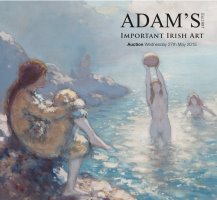
 13
John Luke RUA (1906 - 1975)
A Farmstead, Co. Armagh (1928)
13
John Luke RUA (1906 - 1975)
A Farmstead, Co. Armagh (1928)
Oil on canvas board, 51 x 68.5 cm (20 x 27”)
Signed. Also signed, inscribed with title and dated 1928 verso.
Exhibited: “Northern Rhythm: The Art of John Luke”, The Ulster Museum, November 2012 - April 2013 Catalogue No. 5
Luke entered
A Farmstead in County Armagh
for the 1928 Summer Prize Competition at the Slade School in London and was
awarded the second prize of
£5
. It is an interesting choice of subject, as although many of Luke’s early wanderings around the
Ulster countryside are recorded in his watercolours of the period when he was studying at Belfast College of Art, these appear
predominantly to have taken him along the Lagan towpath and to North Down, Cavehill and the Antrim coast.
Dr. Joseph McBrinn points out that when Luke was forced to flee Belfast with his mother after the 1941 Blitz for the safety of a
farm near Killylea in Armagh, the present work became “a painting in which he now found himself living.” Despite the ongoing
events of the war, Luke seems to have found peace and inspiration at Knappagh Farm, but the calm of those later works is quite
different from the bustling activity outside this farmhouse.
The stylised, exaggerated awkwardness of the figures expresses the energy and physical strain of their work, with the solid
geometric bulk of the house setting up verticals and diagonals that are repeated around the canvas to create a strong dynamic
unity.
A Farmstead in County Armagh
reflects different influences from those we see in other paintings of Luke’s at this time,
such as Stanley and Gilbert Spencer, William Roberts and Thomas Monnington, all of whom had preceded him as students at
the Slade. It is intriguing to note how conscious of contemporary British painting Luke was at this period, although he never
moved closer to the more radical modernism of Stanley Spencer and, in particular, Roberts.
The figures and the narrative element that are both so dominant here are not always a feature of Luke’s painting and it is notable
that they appear to have returned at that time when he was living in Armagh, for example in the 1944 version of
The Locks at
Edenderry, The Old Callan Bridge,
and
Farmhouse, Ballyaghagan,
but the present painting remains unusual within Luke’s work.
Although it suggests paths that he chose not to explore,
A Farmstead in County Armagh
does demonstrate the intelligent and
ambitious manner in which Luke set out to achieve recognition at the Slade in these important competitions.
I. McBrinn, Joseph, Northern Rhythm: The Art of John Luke, NMNI, 2012, p.16
II. Ibid.,p.50
€20,000 - €30,000



















